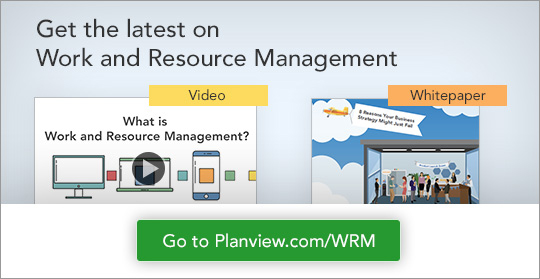
Since 1989, Planview has been on a mission to help every one of our customers realize their resource potential. In the early days this vision translated to a fairly simplistic formula. Resources were typically people and financial in nature, projects were what the resources delivered, and the goal was to ensure the projects were aligned to each organization’s strategy. The solution to this formula was Project Portfolio Management (PPM). Now, we are evolving to work and resource management.
Last week, we held the largest (and IMO the best) Horizons Customer Conference we have ever hosted. As part of the conference, I spoke about how much our world and business climate has changed in recent history. Forces such as changing workforces, digitalization, and the pace of disruption are demanding that we reassess how we attack this more complex version of the traditional resource challenge.
Today, Planview and our customers are poised to take on this new landscape and lead the industry forward not only in PPM, but in the broader domain of Work and Resource Management (WRM).
Why question the status quo, what has changed to cause us to reassess? Here’s what we’ve noticed, see if you agree:
- Outcomes are different. Project success is no longer a successful outcome. The outcomes that matter are the products and services we deliver to the marketplace.
- Capabilities are strategic. Businesses must to take a hard look at what products and services they are delivering today and what they must deliver tomorrow to stay on the cutting edge.
- Work methodologies are proliferating. Projects are just one way we work. Lean, agile, phase-gate, and many more methodologies are all being used in our organizations.
- Unstructured work is exploding. Methodologies can’t solve it all. We need new ways to get work done, collaborate virtually, and execute more quickly.
- Plans are more critical. As we increase speed and agility, it is critical that we have a plan and know where we are going.
- Teams are virtual and global. We need to be able to work together across teams, functions, borders, and companies without adding overhead and constraints.
- Technology is everywhere. These resources are central to every business and can no longer be managed in stovepipes.
- Resources are multiplying in forms that never existed (e.g. IoT).
In this new reality, opportunities are huge, but cost of failure is high. Achieving success is about a seamless, high-velocity translation of strategy into execution. This new landscape makes that goal more complex than ever. PPM, our traditional approach, is still a big part of getting there, but is now only one part of the larger formula for success.
That’s why we introduced the concept of Work and Resource Management to our customers. This broader solution category embraces a vision for a comprehensive spectrum of solutions that consider these needs across every type of organization, addresses a broader set of resources, and acknowledges that we work in different ways.
Over the past several years Planview has been expanding our vision and our offerings to lead this change. WRM is not about one mythical unicorn product. The scope and complexity is too broad. It is about a unifying vision and direction that can help every one of our customers leverage their PPM experience and build new capabilities to meet today’s opportunities.
PPM is a powerful capability for many of our customers, and it will continue to be for a very long time. By embracing WRM we are defining and delivering an even bigger idea, one that can build on the DNA of PPM, embrace today’s broader realities, and allow us to continue to help organizations realize their resource potential.
I’d like to hear from you. Do you agree with the forces outlined? Share your thoughts by leaving a comment below.




